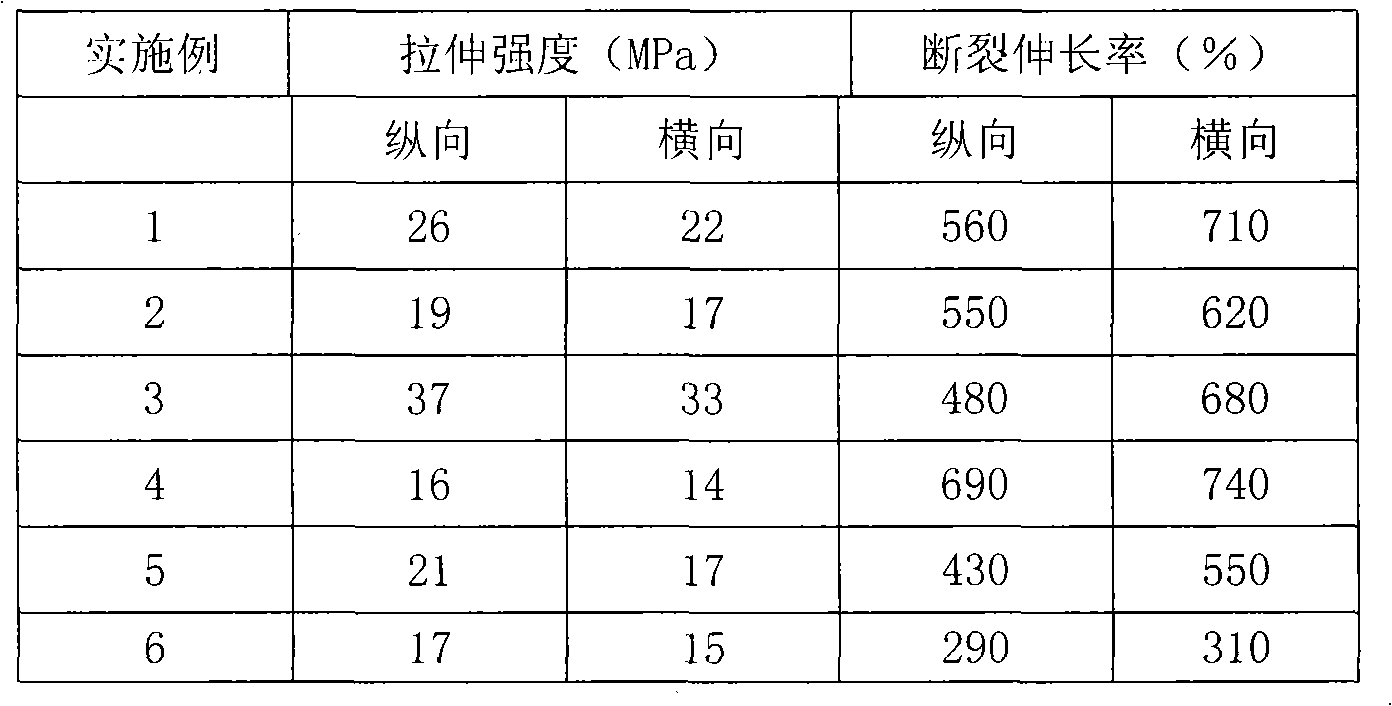Full-biodegradable film with poly-carbonic acid 1,2-propylene diester as substrate and production method thereof
A technology for degrading films and polybutylene succinate, which is applied in the field of fully biodegradable films and preparation methods, can solve the problems of high production cost, poor mechanical properties, and difficulty in large-scale use, and achieves improved melt strength, cost reduction effect
- Summary
- Abstract
- Description
- Claims
- Application Information
AI Technical Summary
Problems solved by technology
Method used
Image
Examples
Embodiment 1
[0023] The number average molecular weight is 108,000g / mol, the polybutylene succinate 30wt of the molecular weight distribution is 4.14 polybutylene succinate 60wt%, the number average molecular weight is 62,000g / mol, and the molecular weight distribution is 2.75 %, PEG-4005wt%, common grade talcum powder 5wt%, premixed in a high-speed mixer at 1000 rpm for 5 minutes, then added to a twin-screw extruder with a length-to-diameter ratio of 20 for blending, at 100-170°C Melt blending and extrusion under low temperature, using water-cooled strands to granulate, the obtained blended material was air-dried at 70°C for 2 hours to remove surface moisture, and the film was blown with a single-screw film blowing machine. The screw speed of the film blowing machine was 25 rpm Minutes, the temperature is controlled to be 100°C in zone I, 140°C in zone II, 170°C in zone III, 165°C in the die, blow-up ratio: 2.5, and a film with a thickness of 0.032mm is prepared. The mechanical properties...
Embodiment 2
[0025] The number average molecular weight is 114,000g / mol, the polybutylene succinate 20wt of the molecular weight distribution is 4.07 polybutylene succinate 60wt%, the number average molecular weight is 48,000g / mol, and the molecular weight distribution is 5.4 %, the number average molecular weight is 55,000g / mol, the molecular weight distribution is 10wt% of polylactic acid of 2.10, PEG-6007wt%, nano-scale silicon dioxide 3wt%, premixed 10 minutes with 1000 rpm in a high-speed mixer, and then Add to a twin-screw extruder with an aspect ratio of 35 for blending, melt blending and extruding at 100-170°C, use water-cooled strands to granulate, and air-dry the obtained blended material at 70°C for 2 hours to remove surface moisture , The film blowing conditions were the same as in Example 1, the inflation ratio: 2.2, and a film with a thickness of 0.040 mm was prepared. The mechanical properties are shown in Table 1.
Embodiment 3
[0027] The number average molecular weight is 72,000g / mol, the polybutylene succinate 20wt of the molecular weight distribution is 5.19 polybutylene succinate 55wt%, the number average molecular weight is 47,000g / mol, and the molecular weight distribution is 5.19 %, with a number average molecular weight of 43,000g / mol and a molecular weight distribution of 3.20, 15wt% of polylactic acid, 6wt% of dibutyl phthalate, 4wt% of nano calcium carbonate, premixed in a high-speed mixer at 1500 rpm 3 minutes, and then blended in a twin-screw extruder with an aspect ratio of 42, melt blended and extruded at 110-190 ° C, and pelletized under water, and the resulting blended material was vacuum-dried at 50 ° C for 4 hours to remove Surface moisture, blow the film with a single-screw film blowing machine, the screw speed of the film blowing machine is 15 rpm, the temperature control is 110°C in zone I, 140°C in zone II, 170°C in zone III, 175°C in the die, and the blowing ratio : 2, a film ...
PUM
| Property | Measurement | Unit |
|---|---|---|
| Number average molecular weight | aaaaa | aaaaa |
| Number average molecular weight | aaaaa | aaaaa |
| Number average molecular weight | aaaaa | aaaaa |
Abstract
Description
Claims
Application Information
 Login to View More
Login to View More - R&D
- Intellectual Property
- Life Sciences
- Materials
- Tech Scout
- Unparalleled Data Quality
- Higher Quality Content
- 60% Fewer Hallucinations
Browse by: Latest US Patents, China's latest patents, Technical Efficacy Thesaurus, Application Domain, Technology Topic, Popular Technical Reports.
© 2025 PatSnap. All rights reserved.Legal|Privacy policy|Modern Slavery Act Transparency Statement|Sitemap|About US| Contact US: help@patsnap.com


